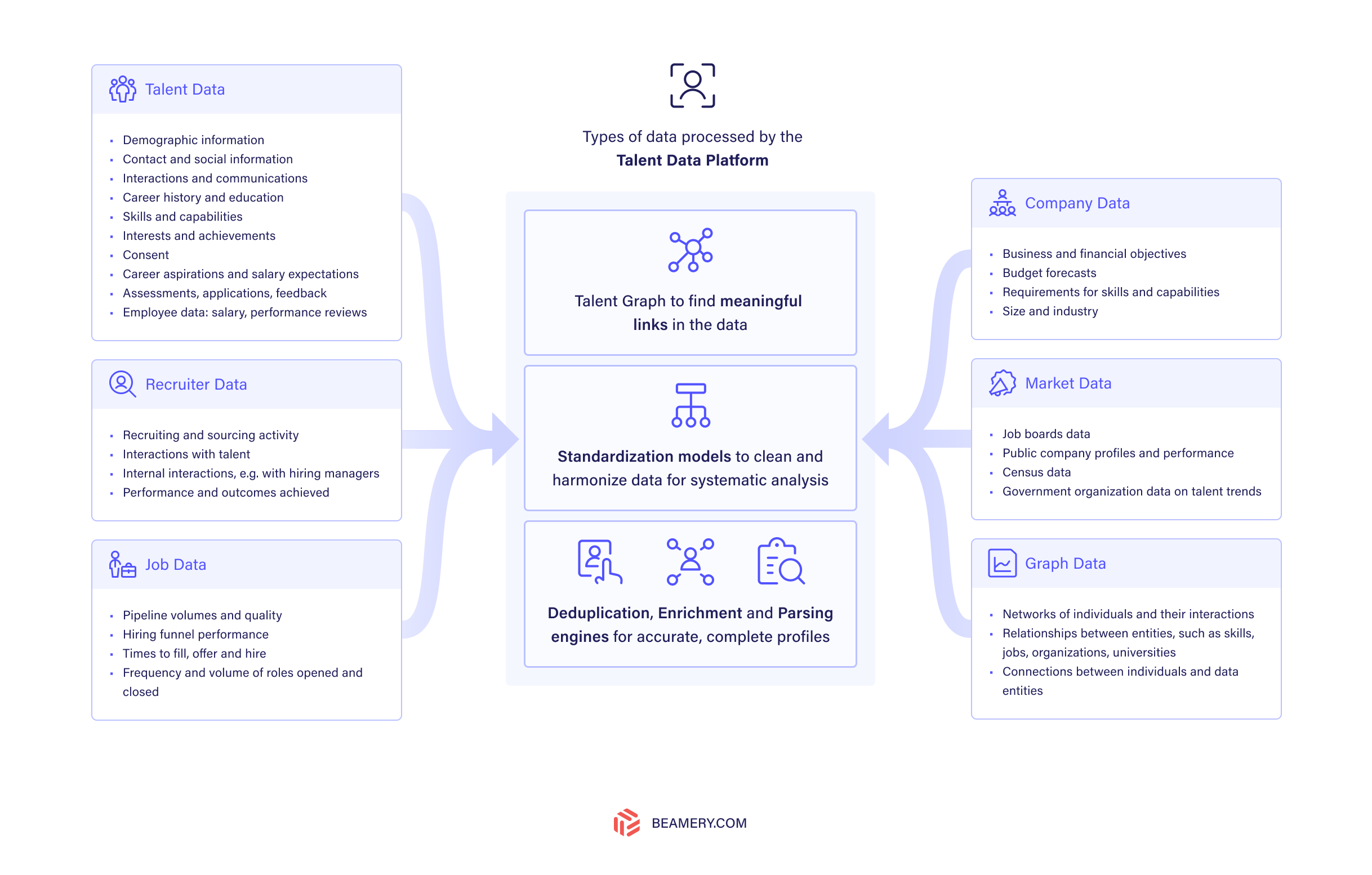The Business Impact of Better Talent Data

Quality talent data positively impacts the whole business on many levels.
Business leaders have recognized that the top internal issue facing their organization is the attraction and retention of top talent. Following the massive loss of jobs of the Covid-19 crisis, the pressure on talent teams to be more efficient and deliver better value will only increase. For many of them, this will start with ensuring they have access to better talent data.
Improving the quality of talent data is often central to any conversation about the Future of Work, and for good reason: without a foundation of strong data management and analysis, without the right infrastructure as well as the right skill sets in talent teams, the people organization is not prepared for the future.
What does better talent data look like?
There are two different dimensions to good talent data:
The quality of the data itself
Things like location, behaviors, or current job descriptions change constantly for every candidate. With more and more recruiting activities shifting towards a more proactive strategy, having the right candidate data in your database is crucial. It means your campaigns will land better, your recruiters can be more effective, your talent attraction tactics more targeted.
How recruiters improve the quality of their talent data differs from one organization to the next, but many teams simply use automation to help with cleaning or deduplicating talent data, as well as enrichment engines that regularly scour the internet for more recent data points.
The aim is to have up-to-date, clean, and unified data across the board. This makes it easier to search, filter, use in personalized campaigns or sourcing activities, as well as automated workflows as we will discuss below.
The ability to use and access this data at scale
Having beautifully curated databases is not enough, if talent teams cannot use them to their full benefit. On one hand, they need the right recruitment analytics skills to even know what to do with it, and on the other, their talent technology ecosystem needs to be set up in a way that enables all talent data to communicate with each other, and sit in the same single source of truth. Talent data platforms play that role for the talent team, by being the central database that unifies information across solutions, and surfacing meaningful, reliable data to every other talent tool.

Unlocking new value with better talent data
Better talent data means that the team can report on productivity and improve resource management in many ways, but the most valuable business impact of better recruitment data might be in the actions or processes that it makes possible. That is how talent teams can grow.
Most talent tools today deal in job titles and company names, but the right AI technology can translate large databases of job titles and company names into skill families, industries, or functional expertise. It can also relate financial information and market insights to hiring needs, making candidate screening, job matching, and even workforce planning with AI,far more powerful than its current alternative.

AI and machine learning, especially, can identify and suggest improved workflows to recruiters. An AI algorithm can identify where desired outcomes, such as higher performance reviews, or faster promotions, correlate with certain candidate attributes, and highlight better matches for future roles. Machine-learning algorithms can also learn to do semantic searches in candidate or job databases to find the right skills for recruiters in places where they are not used to looking.
For this to be possible, ML algorithms can learn from training datasets that recruiting teams can put together, or from repeated action-feedback loops every time the algorithm gives a suggestion to the recruiter and receives feedback.
However, training datasets require better recruiting and candidate data quality; databases that do not hold basic information only relating to the candidate or the job, but also information on how different data points relate to each other. For example, what makes a VP role in this company less senior than a Director role in this other company? What drivers seem to correlate with time-to-fill, and can they be used to forecast how long a role will take to be filled? For an algorithm to learn to answer these questions, they have to find examples of such information in the existing databases.
We hear more and more about how artificial intelligence will impact hiring decisions, how talent automation and AI are already here, and how AI can transform recruiting. The thing to keep in mind, however, is that even the best AI technology in the world is only as good as the data you feed it. For companies looking to upgrade their talent technology in that direction, the first investment should be made in obtaining better talent data.
Missing out on Talent Lifecycle Management: Why Bad Data might cost you your talent transformation
Without quality data, your talent team cannot leverage AI in its talent transformation plans. That means no enhanced talent sourcing, or candidate matching, or recruiter workflow optimization, or intelligent workforce planning. More importantly, it means no ability to adapt to the modern talent market, which demands that you approach talent holistically.
One way in which AI will be extremely valuable to talent teams in the near future is by inferring skills and capabilities from past companies, job titles and other data points in the candidate profile. This means being able to look at candidates and employees as individuals with a living, evolving set of skills with dynamic levels of proficiency, and not as static collections of requirements that fit an existing open role.
In other words, companies will soon be able to look at an individual and understand not only the skills they have today and the value they can currently bring to the business, but how they can and want to grow, and how they might grow with the business.
Looking at the accelerated evolution that the world of work has gone through recently, it is unrealistic to expect that you can get away with approaching talent management the same way you did pre-pandemic.
The future of talent acquisition and management is already starting to shift towards talent lifecycle management- see our recent webinar with AstraZeneca to hear what this might look like. Your talent teams should be thinking in terms of hybrid working models, full-time and part-time, contract, project-based, in-person and remotely based. They should be able to build pipelines for the future and support workforce planning by considering the needs of the business and the potential of their candidates. All of which they cannot do with quality talent data to feed into their talent AI.
And that is one of the most concerning potential costs of bad talent data. Whether it is to improve your workforce planning or shift your perspective on internal mobility or talent attraction, AI will play a foundational role in your talent strategy in the next few years. and without better talent data to power it, you will miss out on your ability to transform your talent acquisition and management organization.
Thinking about the Future of Work brings more value to the HR organization when it’s about future-proofing than about predicting the future. In other words, it is not about trying to predict which version of the future is likely to happen; no one can guarantee that their forecasts will always be 100% accurate, and so that strategy carries too much risk. What competitive talent teams are trying to do today is to separate the “likely” outcomes from the “certain” ones, plan for the first, and mitigate for second.
An increasing reliance on talent data, and on experts who can easily analyse and interpret it, is inevitable. The acceleration of digital transformation, the adoption of talent data platforms, and the push towards consolidated talent technology are all signs that point towards it. The positive impact of better talent data is clear to business executives; the question that remains is how the organization will choose to achieve it.